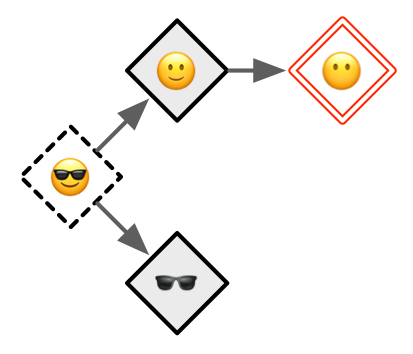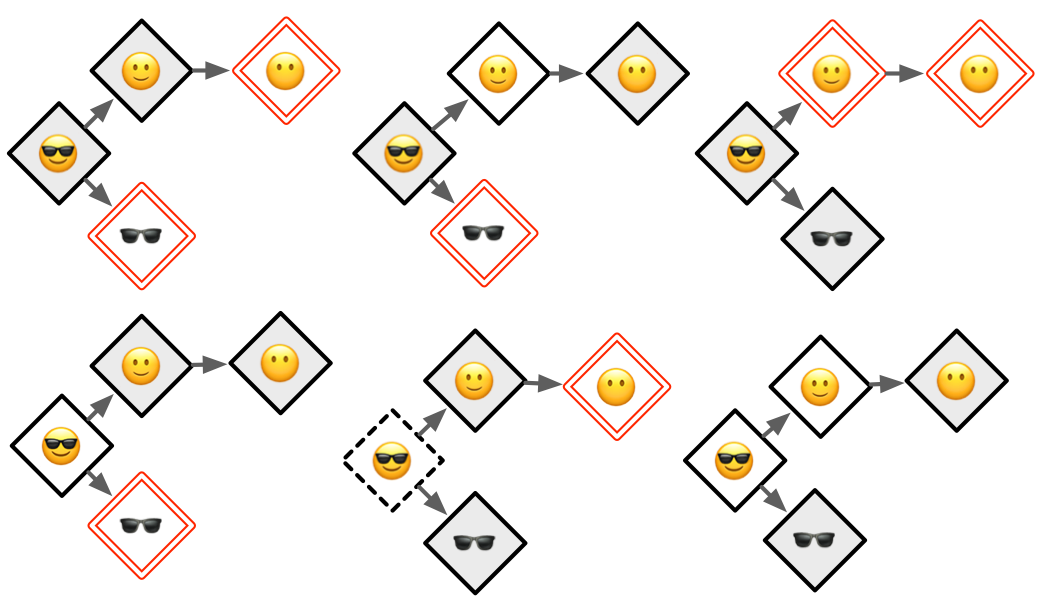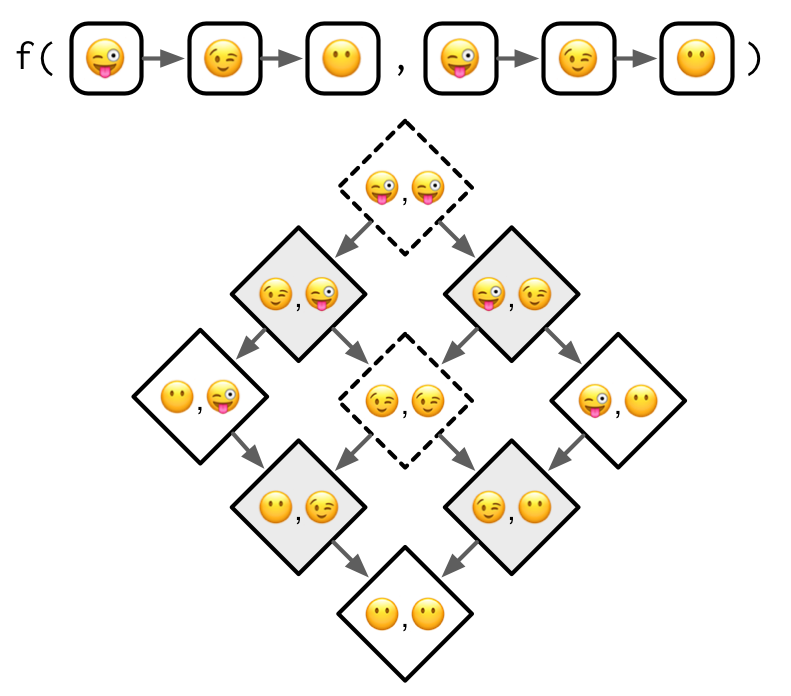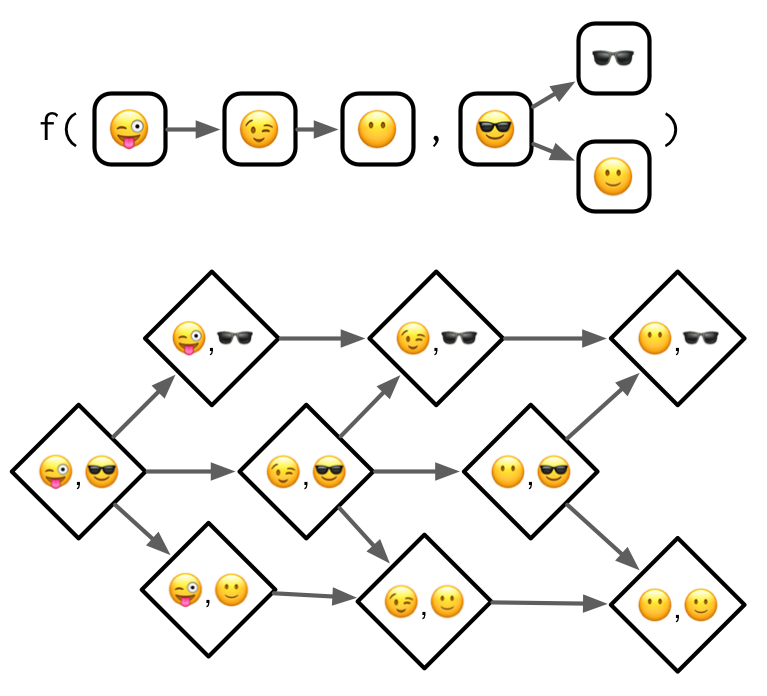15.5 Method dispatch
S4 dispatch is complicated because S4 has two important features:
- Multiple inheritance, i.e. a class can have multiple parents,
- Multiple dispatch, i.e. a generic can use multiple arguments to pick a method.
These features make S4 very powerful, but can also make it hard to understand which method will get selected for a given combination of inputs. In practice, keep method dispatch as simple as possible by avoiding multiple inheritance, and reserving multiple dispatch only for where it is absolutely necessary.
But it’s important to describe the full details, so here we’ll start simple with single inheritance and single dispatch, and work our way up to the more complicated cases. To illustrate the ideas without getting bogged down in the details, we’ll use an imaginary class graph based on emoji:

Emoji give us very compact class names that evoke the relationships between the classes. It should be straightforward to remember that 😜 inherits from 😉 which inherits from 😶, and that 😎 inherits from both 🕶 and 🙂.
15.5.1 Single dispatch
Let’s start with the simplest case: a generic function that dispatches on a single class with a single parent. The method dispatch here is simple so it’s a good place to define the graphical conventions we’ll use for the more complex cases.

There are two parts to this diagram:
The top part,
f(...), defines the scope of the diagram. Here we have a generic with one argument, that has a class hierarchy that is three levels deep.The bottom part is the method graph and displays all the possible methods that could be defined. Methods that exist, i.e. that have been defined with
setMethod(), have a grey background.
To find the method that gets called, you start with the most specific class of the actual arguments, then follow the arrows until you find a method that exists. For example, if you called the function with an object of class 😉 you would follow the arrow right to find the method defined for the more general 😶 class. If no method is found, method dispatch has failed and an error is thrown. In practice, this means that you should alway define methods defined for the terminal nodes, i.e. those on the far right.
There are two pseudo-classes that you can define methods for. These are called pseudo-classes because they don’t actually exist, but allow you to define useful behaviours. The first pseudo-class is ANY which matches any class56. For technical reasons that we’ll get to later, the link to the ANY method is longer than the links between the other classes:

The second pseudo-class is MISSING. If you define a method for this pseudo-class, it will match whenever the argument is missing. It’s not useful for single dispatch, but is important for functions like + and - that use double dispatch and behave differently depending on whether they have one or two arguments.
15.5.2 Multiple inheritance
Things get more complicated when the class has multiple parents.

The basic process remains the same: you start from the actual class supplied to the generic, then follow the arrows until you find a defined method. The wrinkle is that now there are multiple arrows to follow, so you might find multiple methods. If that happens, you pick the method that is closest, i.e. requires travelling the fewest arrows.
NB: while the method graph is a powerful metaphor for understanding method dispatch, implementing it in this way would be rather inefficient, so the actual approach that S4 uses is somewhat different. You can read the details in ?Methods_Details.
What happens if methods are the same distance? For example, imagine we’ve defined methods for 🕶 and 🙂, and we call the generic with 😎. Note that no method can be found for the 😶 class, which I’ll highlight with a red double outline.

This is called an ambiguous method, and in diagrams I’ll illustrate it with a thick dotted border. When this happens in R, you’ll get a warning, and the method for the class that comes earlier in the alphabet will be picked (this is effectively random and should not be relied upon). When you discover ambiguity you should always resolve it by providing a more precise method:

The fallback ANY method still exists but the rules are little more complex. As indicated by the wavy dotted lines, the ANY method is always considered further away than a method for a real class. This means that it will never contribute to ambiguity.

With multiple inheritances it is hard to simultaneously prevent ambiguity, ensure that every terminal method has an implementation, and minimise the number of defined methods (in order to benefit from OOP). For example, of the six ways to define only two methods for this call, only one is free from problems. For this reason, I recommend using multiple inheritance with extreme care: you will need to carefully think about the method graph and plan accordingly.

15.5.3 Multiple dispatch
Once you understand multiple inheritance, understanding multiple dispatch is straightforward. You follow multiple arrows in the same way as previously, but now each method is specified by two classes (separated by a comma).

I’m not going to show examples of dispatching on more than two arguments, but you can follow the basic principles to generate your own method graphs.
The main difference between multiple inheritance and multiple dispatch is that there are many more arrows to follow. The following diagram shows four defined methods which produce two ambiguous cases:

Multiple dispatch tends to be less tricky to work with than multiple inheritance because there are usually fewer terminal class combinations. In this example, there’s only one. That means, at a minimum, you can define a single method and have default behaviour for all inputs.
15.5.4 Multiple dispatch and multiple inheritance
Of course you can combine multiple dispatch with multiple inheritance:

A still more complicated case dispatches on two classes, both of which have multiple inheritance:

As the method graph gets more and more complicated it gets harder and harder to predict which method will get called given a combination of inputs, and it gets harder and harder to make sure that you haven’t introduced ambiguity. If you have to draw diagrams to figure out what method is actually going to be called, it’s a strong indication that you should go back and simplify your design.
15.5.5 Exercises
Draw the method graph for
f(😅, 😽).Draw the method graph for
f(😃, 😉, 😙).Take the last example which shows multiple dispatch over two classes that use multiple inheritance. What happens if you define a method for all terminal classes? Why does method dispatch not save us much work here?
The S4
ANYpseudo-class plays the same role as the S3defaultpseudo-class.↩︎